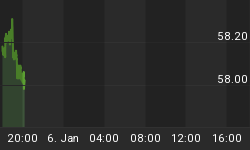The visible dangers of derivatives have been well documented on the internet, as the dangers of their collapse have the same potential as the sub-prime crisis is having now, but the long-term upward drive in commodity prices should limit the threat to a process of de-leveraging, as we have already seen in the large lowering of net speculative long gold positions on COMEX. But we are going to highlight a potentially more destructive facet of derivative here.
Simply put, a derivative is a 'paper' instrument founded on an asset. It can be a purchase or sale of a commodity in the future, or a share in an Exchange Traded Fund, an Option, or one of many similar instruments.
The Classic Use of a Derivative
When a silver miner or user found they had to buy or sell silver, they would usually buy ahead of the date of their need to ensure its availability on that date, but this left them exposed to the dangers of paying too much or selling for too little. How could they remove this risk? They had to "hedge" their future sale. How?
If delivery of silver sold/bought were to take place say in a year's time, they would sell/buy that position in the futures market or take out a "put/"call"" option [the right to sell/buy at a certain price at that future date]. This left them both a long position and a short position on silver [netting out at a "neutral" position on the silver].
If the price then moved substantially either way, out of expectationed price levels they culd protect themselves fairly easily. How? If the price were to go down they could then close the "short" position by buying the same quantity at the lower price to 'close out' at the same date as the 'short' [sale]. This would leave them "net" 'long' at the lower price. They would then sell that position again at the lower price, with the profit from the closed position in hand. Their customer would then get their silver at the future market price on delivery date.
But perhas the price suddenly rose on the original netted out position, what then? Then they could sell the same amount a second time to establish the higher price, which their customer would accept as the market price. After this the price may reverse in which case they would the buy the silver back at the lower price, profiting from the 'short' position, leaving the 'long' position that they originally had, again and still able to repeat the operation for profit. This could happen time and time again durng the life of the contract until delivery. This could eventually end up as 100 positions having been dealt, 'netting out' eventually at the single sale of silver, which would then be delivered to the customer as originally planned. As you can see this would be relatively low risk and allow the silver principal to 'protect' himself against moves in the metals price, for profit.
But then pure speculation came in to the market, briging volatlity to the silver price [and all other items on the futures and options markets] alongside of investment positons protecting the value of the investment funds from the depreciation of money values, as we can see in the markets at the moment. This use of these exchanges is now where market distortions are beginning to wreak havoc.
Dangerous, Speculative and Investment Positions on Comex
The dangers we now focus on in this article are the effects of the huge investment funds being 'parked' in these instruments, enjoying the price rises in commodities, etc, with no intention of taking delivery or consuming the items. We are seeing this happen in oil, wheat, rice as well as gold and silver and other precious metals plus other items demanded by a growing percentage of the globe's population, particularly in emerging and poor nations. If this feature were not present, the prices of these items would be much lower right now, at least for the near-term, while real demand continued to grow with the 'emergence' of poorer economies across the globe. For instance 37% of the COMEX positions in the oil market are investment positions riding the oil price with no intention of taking delivery. Of course poorer nations cannot afford these high prices, nor can anyone.
Investment Controls!
How can the authorities help on this front?
- Any move to discourage such actions would have to be employed, such as through raising margins [usually a 10% depoist asked whenever a futures contract is entered into], which we believe would be a relatively ineffective. This ploy is used occaionally to take the steam out of a price, but rarely on a permanent or even semi-permanent basis.
- Or the refusal by the options or futures markets to accept purchases or sales of such items unless the principals can evidence the intention and competence to take delivery of the item at the end of the cntract. This is a "Capital Control", irrespective of its name.
- We are seeing this control presently expressed in the form of the restrictions of exports of food items from countries where local demand is not being met locally. We see these controls in several emerging nations as price move out of their affordability range. Riots in places like Haiti against food prices are becoming more and more common. This situation can only get worse!
 Are you properly structured to fend off the negative impact of these changes like Financial Controls on YOUR investments? [Subscribers contact us on this subject]
Are you properly structured to fend off the negative impact of these changes like Financial Controls on YOUR investments? [Subscribers contact us on this subject]
"Gold & Silver will benefit from this rising drama!"
For our regular weekly newsletter, please visit www.GoldForecaster.com.
















